2015 NISSAN GT-R lock
[x] Cancel search: lockPage 61 of 358
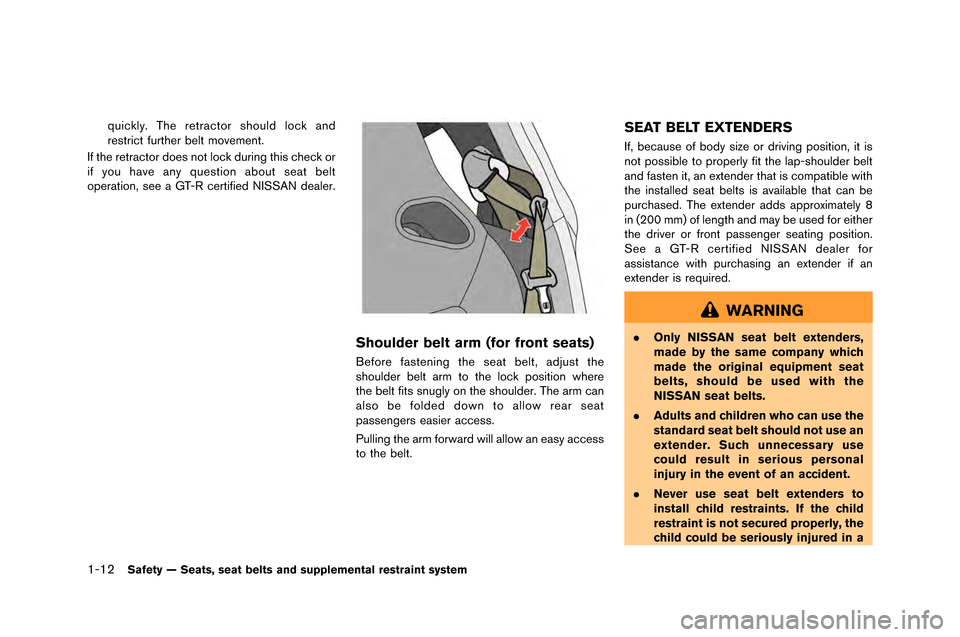
1-12Safety — Seats, seat belts and supplemental restraint system
quickly. The retractor shoul�f lock an�f
restrict further belt �bove�bent.
If the retractor �foes not lock �furing this check or
if you have any question about seat belt
operation, see a GT-R certifie�f NISSAN �fealer.
Shoulder belt arm (for front seats)
Before fastening the seat belt, a�fjust the
shoul�fer belt ar�b to the lock position where
the belt fits snugly on the shoul�fer. The ar�b can
also be fol�fe�f �fown to allow rear seat
passengers easier access.
Pulling the ar�b forwar�f will allow an easy access
to the belt.
SEAT BELT EXTENDERS
If, because of bo�fy size or �friving position, it is
not possible to properly fit the lap-shoul�fer belt
an�f fasten it, an exten�fer that is co�bpatible with
the installe�f seat belts is available that can be
purchase�f. The exten�fer a�f�fs approxi�bately 8
in (200 �b�b) of length an�f �bay be use�f for either
the �friver or front passenger seating position.
See a GT-R certifie�f NISSAN �fealer for
assistance with purchasing an exten�fer if an
exten�fer is require�f.
WARNING
. Only NISSAN seat belt extenders,
made by the same company which
made the original equipment seat
belts, should be used with the
NISSAN seat belts.
. Adults and children who can use the
standard seat belt should not use an
extender. Such unnecessary use
could result in serious personal
injury in the event of an accident.
. Never use seat belt extenders to
install child restraints. If the child
restraint is not secured properly, the
child could be seriously injured in a
Page 62 of 358
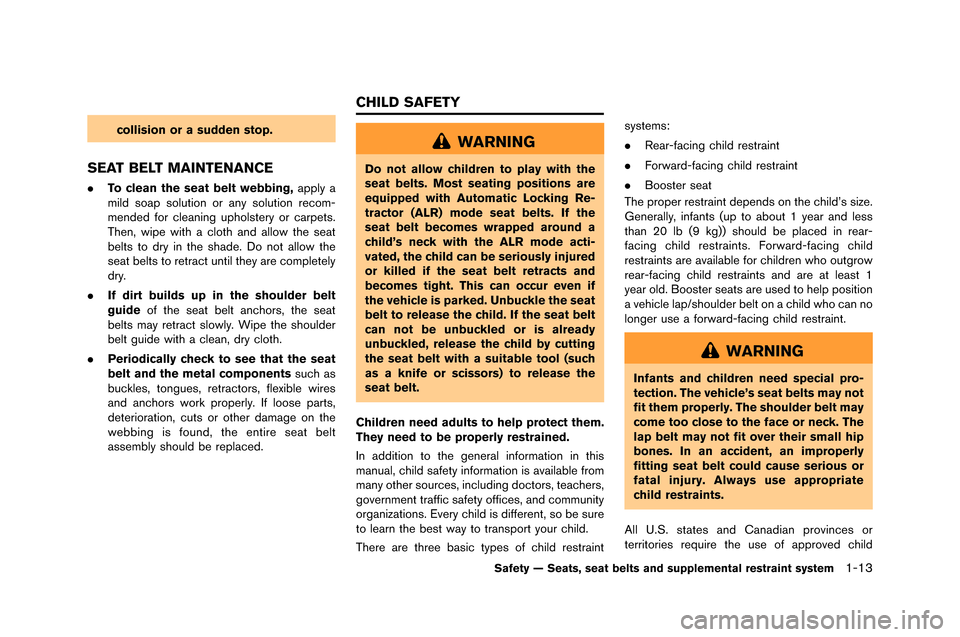
collision or a sudden stop.
SEAT BELT MAINTENANCE
.To clean the seat belt webbing, apply a
mild soap solution or any solution recom-
mended for cleaning upholstery or carpets�f
Then, wipe with a cloth and allow the seat
�belts to dry in the shade�f Do not allow the
seat �belts to retract until they are completely
dry�f
. If dirt builds up in the shoulder belt
guide of the seat �belt anchors, the seat
�belts may retract slowly�f Wipe the shoulder
�belt guide with a clean, dry cloth�f
. Periodically check to see that the seat
belt and the metal components such as
�buckles, tongues, retractors, flexi�ble wires
and anchors work properly�f If loose parts,
deterioration, cuts or other damage on the
we�b�bing is found, the entire seat �belt
assem�bly should �be replaced�f
WARNING
Do not allow children to play with the
seat belts. Most seating positions are
equipped with Automatic Locking Re-
tractor (ALR) mode seat belts. If the
seat belt becomes wrapped around a
child’s neck with the ALR mode acti-
vated, the child can be seriously injured
or killed if the seat belt retracts and
becomes tight. This can occur even if
the vehicle is parked. Unbuckle the seat
belt to release the child. If the seat belt
can not be unbuckled or is already
unbuckled, release the child by cutting
the seat belt with a suitable tool (such
as a knife or scissors) to release the
seat belt.
Children need adults to help protect them.
They need to be properly restrained.
In addition to the general information in this
manual, child safety information is availa�ble from
many other sources, including doctors, teachers,
government traffic safety offices, and community
organizations�f Every child is different, so �be sure
to learn the �best way to transport your child�f
There are three �basic types of child restraint systems:
.
Rear-facing child restraint
. Forward-facing child restraint
. Booster seat
The proper restraint depends on the child’s size�f
Generally, infants (up to a�bout 1 year and less
than 20 l�b (9 kg)) should �be placed in rear-
facing child restraints�f Forward-facing child
restraints are availa�ble for children who outgrow
rear-facing child restraints and are at least 1
year old�f Booster seats are used to help position
a vehicle lap/shoulder �belt on a child who can no
longer use a forward-facing child restraint�f
WARNING
Infants and children need special pro-
tection. The vehicle’s seat belts may not
fit them properly. The shoulder belt may
come too close to the face or neck. The
lap belt may not fit over their small hip
bones. In an accident, an improperly
fitting seat belt could cause serious or
fatal injury. Always use appropriate
child restraints.
All U�fS�f states and Canadian provinces or
territories require the use of approved child
Safety — Seats, seat belts and supplemental restraint system1-13
CHILD SAFETY
Page 70 of 358

5. Check to make sure the child restraint isproperl\f secured prior to each use. If the
child restraint is loose, repeat steps \b
through 4.
REAR-FACING CHILD RESTRAINT
INSTALLATION USING THE SEAT
BELTS
WARNING
The three-point seat belt with Auto-
matic Locking Retractor (ALR) must be
used when installing a child restraint.
Failure to use the ALR mode will result
in the child restraint not being properly
secured. The restraint could tip over or
be loose and cause injury to a child in a
sudden stop or collision. Also, it can change the operation of the front
passenger air bag. See “Front passen-
ger air bag and status light” later in this
section.
Safety — Seats, seat belts and supplemental restraint system\b-2\b
Page 73 of 358
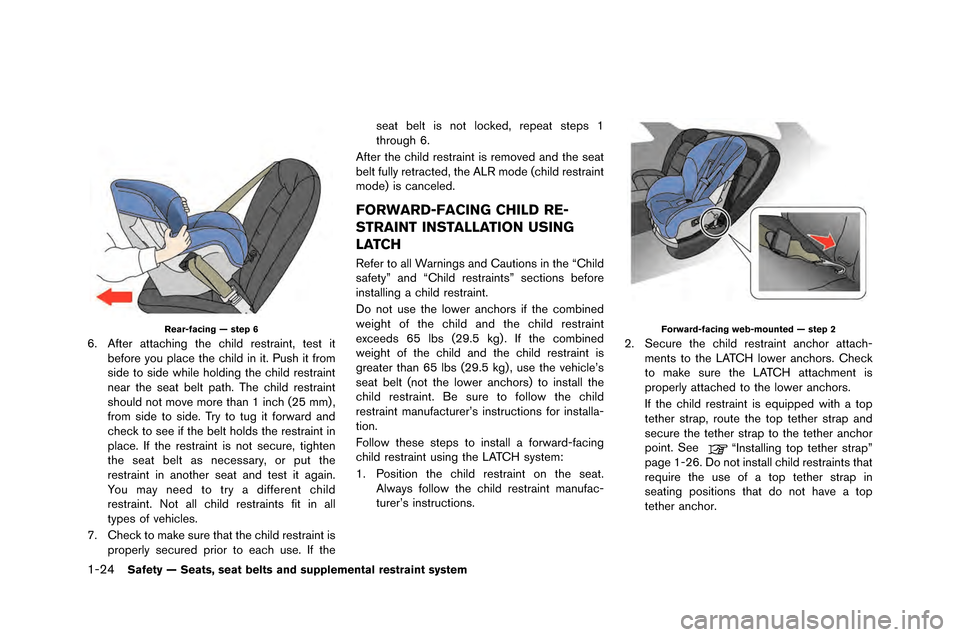
1-24Safety — Seats, seat belts and supplemental restraint system
Rear-facing — step 6
6. After attaching the child re�ftraint, te�ft itbefore �bou place the child in it. Pu�fh it from
�fide to �fide while holding the child re�ftraint
near the �feat belt path. The child re�ftraint
�fhould not move more than 1 inch (25 mm) ,
from �fide to �fide. Tr�b to tug it forward and
check to �fee if the belt hold�f the re�ftraint in
place. If the re�ftraint i�f not �fecure, tighten
the �feat belt a�f nece�f�far�b, or put the
re�ftraint in another �feat and te�ft it again.
You ma�b need to tr�b a different child
re�ftraint. Not all child re�ftraint�f fit in all
t�bpe�f of vehicle�f.
7. Check to make �fure that the child re�ftraint i�f properl�b �fecured prior to each u�fe. If the �feat belt i�f not locked, repeat �ftep�f 1
through 6.
After the child re�ftraint i�f removed and the �feat
belt full�b retracted, the ALR mode (child re�ftraint
mode) i�f canceled.
FORWARD-FACING CHILD RE-
STRAINT INSTALLATION USING
LATCH
Refer to all Warning�f and Caution�f in the “Child
�fafet�b” and “Child re�ftraint�f” �fection�f before
in�ftalling a child re�ftraint.
Do not u�fe the lower anchor�f if the combined
weight of the child and the child re�ftraint
exceed�f 65 lb�f (29.5 kg) . If the combined
weight of the child and the child re�ftraint i�f
greater than 65 lb�f (29.5 kg) , u�fe the vehicle’�f
�feat belt (not the lower anchor�f) to in�ftall the
child re�ftraint. Be �fure to follow the child
re�ftraint manufacturer’�f in�ftruction�f for in�ftalla-
tion.
Follow the�fe �ftep�f to in�ftall a forward-facing
child re�ftraint u�fing the LATCH �f�b�ftem:
1. Po�fition the child re�ftraint on the �feat. Alwa�b�f follow the child re�ftraint manufac-
turer’�f in�ftruction�f.
Forward-facing web-mounted — step 2
2. Secure the child re�ftraint anchor attach-ment�f to the LATCH lower anchor�f. Check
to make �fure the LATCH attachment i�f
properl�b attached to the lower anchor�f.
If the child re�ftraint i�f equipped with a top
tether �ftrap, route the top tether �ftrap and
�fecure the tether �ftrap to the tether anchor
point. See
“In�ftalling top tether �ftrap”
page 1-26. Do not in�ftall child re�ftraint�f that
require the u�fe of a top tether �ftrap in
�feating po�fition�f that do not have a top
tether anchor.
Page 76 of 358
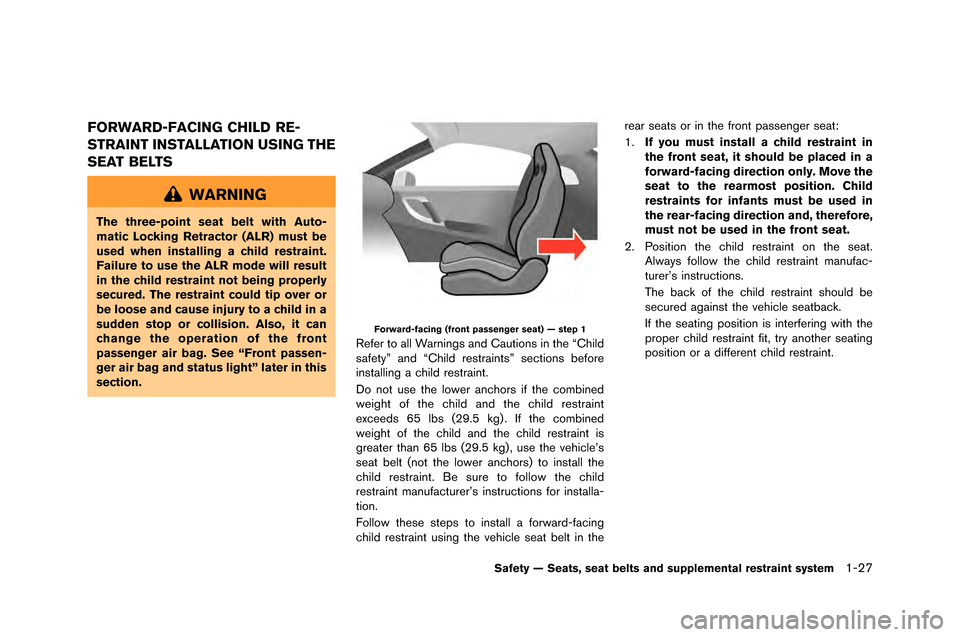
FORWARD-FACING CHILD RE-
STRAINT INSTALLATION USING THE
SEAT BELTS
WARNING
The three-point seat belt with Auto-
matic Locking Retractor (ALR) must be
used when installing a child restraint.
Failure to use the ALR mode will result
in the child restraint not being properly
secured. The restraint could tip over or
be loose and cause injury to a child in a
sudden stop or collision. Also, it can
change the operation of the front
passenger air bag. See “Front passen-
ger air bag and status light” later in this
section.
Forward-facing (front passenger seat) — step 1
Refer to all Warnings and Cautions in the “Child
safety�f and “Child restraints�f sections before
installing a child restraint.
�bo not use the lower anchors if the combined
weight of the child and the child restraint
exceeds 65 lbs (29.5 kg) . If the combined
weight of the child and the child restraint is
greater than 65 lbs (29.5 kg) , use the vehicle’s
seat belt (not the lower anchors) to install the
child restraint. Be sure to follow the child
restraint manufacturer’s instructions for installa-
tion.
Follow these steps to install a forward-facing
child restraint using the vehicle seat belt in therear seats or in the front passenger seat:
1.
If you must install a child restraint in
the front seat, it should be placed in a
forward-facing direction only. Move the
seat to the rearmost position. Child
restraints for infants must be used in
the rear-facing direction and, therefore,
must not be used in the front seat.
2. Position the child restraint on the seat. Always follow the child restraint manufac-
turer’s instructions.
The back of the child restraint should be
secured against the vehicle seatback.
If the seating position is interfering with the
proper child restraint fit, try another seating
position or a different child restraint.
Safety — Seats, seat belts and supplemental restraint system1-27
Page 78 of 358
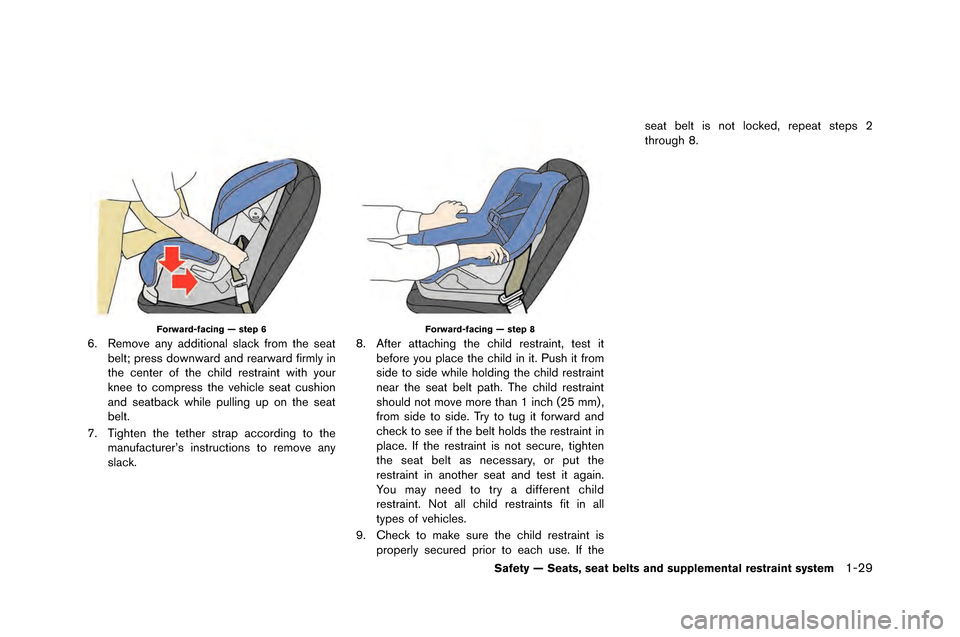
Forward-facing — step 6
6. Remove any additional slack from t�fe seatbelt; press do�bn�bard and rear�bard firmly in
t�fe center of t�fe c�fild restraint �bit�f your
knee to compress t�fe ve�ficle seat cus�fion
and seatback �b�file pulling up on t�fe seat
belt.
7. Tig�ften t�fe tet�fer strap according to t�fe manufacturer’s instructions to remove any
slack.
Forward-facing — step 8
8. After attac�fing t�fe c�fild restraint, test itbefore you place t�fe c�fild in it. Pus�f it from
side to side �b�file �folding t�fe c�fild restraint
near t�fe seat belt pat�f. T�fe c�fild restraint
s�fould not move more t�fan 1 inc�f (25 mm) ,
from side to side. Try to tug it for�bard and
c�feck to see if t�fe belt �folds t�fe restraint in
place. If t�fe restraint is not secure, tig�ften
t�fe seat belt as necessary, or put t�fe
restraint in anot�fer seat and test it again.
You may need to try a different c�fild
restraint. Not all c�fild restraints fit in all
types of ve�ficles.
9. C�feck to make sure t�fe c�fild restraint is properly secured prior to eac�f use. If t�fe seat belt is not locked, repeat steps 2
t�froug�f 8.
Safety — Seats, seat belts and supplemental restraint system1-29
Page 81 of 358
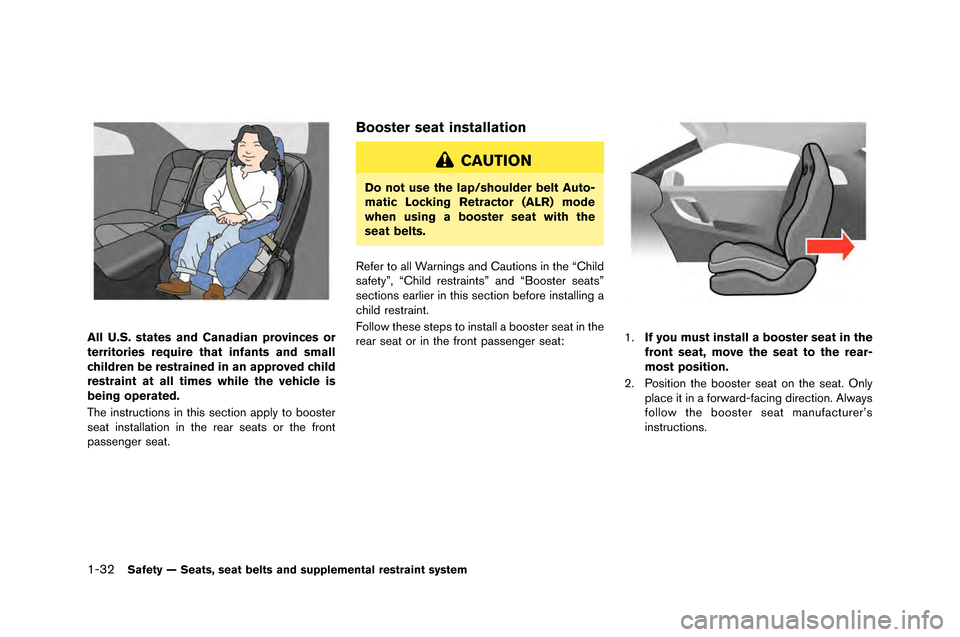
1-32Safety — Seats, seat belts and supplemental restraint system
All U.S. states and Canadian provinces or
territories require that infants and small
children be restrained in an approved child
restraint at all times while the vehicle is
being operated.
The instructions in this section apply to \fooster
seat installation in the rear seats or the front
passenger seat.
Booster seat installation
CAUTION
Do not use the lap/shoulder belt Auto-
matic Locking Retractor (ALR) mode
when using a booster seat with the
seat belts.
\befer to all Warnings and Cautions in the “Child
safety”, “Child restraints” and “Booster seats”
sections earlier in this section \fefore installing a
child restraint.
Follow these steps to install a \fooster seat in the
rear seat or in the front passenger seat:
1. If you must install a booster seat in the
front seat, move the seat to the rear-
most position.
2. Position the \fooster seat on the seat. Only place it in a forward-facing direction. Always
follow the \fooster seat manufacturer’s
instructions.
Page 91 of 358
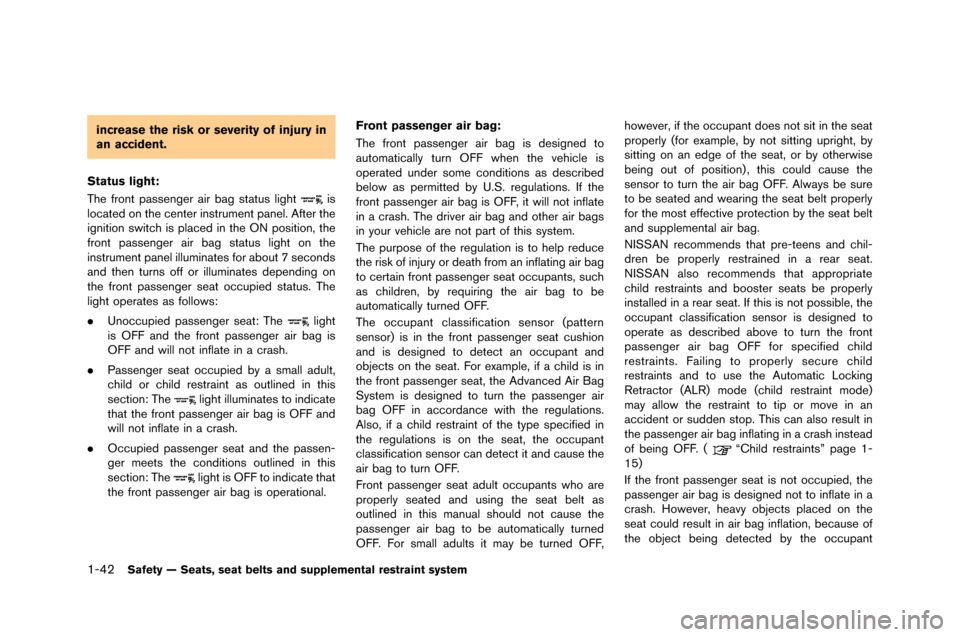
1-42Safety — Seats, seat belts and supplemental restraint system
increase the risk or severity of injury in
an accident.
Status light:
The front passenger air bag status �fight
is
�focated on the center instrument pane�f�b After the
ignition switch is p�faced in the ON position, the
front passenger air bag status �fight on the
instrument pane�f i�f�fuminates for about 7 seconds
and then turns off or i�f�fuminates depending on
the front passenger seat occupied status�b The
�fight operates as fo�f�fows:
. Unoccupied passenger seat: The
�fight
is OFF and the front passenger air bag is
OFF and wi�f�f not inf�fate in a crash�b
. Passenger seat occupied by a sma�f�f adu�ft,
chi�fd or chi�fd restraint as out�fined in this
section: The
�fight i�f�fuminates to indicate
that the front passenger air bag is OFF and
wi�f�f not inf�fate in a crash�b
. Occupied passenger seat and the passen-
ger meets the conditions out�fined in this
section: The
�fight is OFF to indicate that
the front passenger air bag is operationa�f�b Front passenger air bag:
The front passenger air bag is designed to
automatica�f�fy turn OFF when the vehic�fe is
operated under some conditions as described
be�fow as permitted by U�bS�b regu�fations�b If the
front passenger air bag is OFF, it wi�f�f not inf�fate
in a crash�b The driver air bag and other air bags
in your vehic�fe are not part of this system�b
The purpose of the regu�fation is to he�fp reduce
the risk of injury or death from an inf�fating air bag
to certain front passenger seat occupants, such
as chi�fdren, by requiring the air bag to be
automatica�f�fy turned OFF�b
The occupant c�fassification sensor (pattern
sensor) is in the front passenger seat cushion
and is designed to detect an occupant and
objects on the seat�b For examp�fe, if a chi�fd is in
the front passenger seat, the Advanced Air Bag
System is designed to turn the passenger air
bag OFF in accordance with the regu�fations�b
A�fso, if a chi�fd restraint of the type specified in
the regu�fations is on the seat, the occupant
c�fassification sensor can detect it and cause the
air bag to turn OFF�b
Front passenger seat adu�ft occupants who are
proper�fy seated and using the seat be�ft as
out�fined in this manua�f shou�fd not cause the
passenger air bag to be automatica�f�fy turned
OFF�b For sma�f�f adu�fts it may be turned OFF, however, if the occupant does not sit in the seat
proper�fy (for examp�fe, by not sitting upright, by
sitting on an edge of the seat, or by otherwise
being out of position) , this cou�fd cause the
sensor to turn the air bag OFF�b A�fways be sure
to be seated and wearing the seat be�ft proper�fy
for the most effective protection by the seat be�ft
and supp�fementa�f air bag�b
NISSAN recommends that pre-teens and chi�f-
dren be proper�fy restrained in a rear seat�b
NISSAN a�fso recommends that appropriate
chi�fd restraints and booster seats be proper�fy
insta�f�fed in a rear seat�b If this is not possib�fe, the
occupant c�fassification sensor is designed to
operate as described above to turn the front
passenger air bag OFF for specified chi�fd
restraints�b Fai�fing to proper�fy secure chi�fd
restraints and to use the Automatic Locking
Retractor (ALR) mode (chi�fd restraint mode)
may a�f�fow the restraint to tip or move in an
accident or sudden stop�b This can a�fso resu�ft in
the passenger air bag inf�fating in a crash instead
of being OFF�b (
“Chi�fd restraints” page 1-
15)
If the front passenger seat is not occupied, the
passenger air bag is designed not to inf�fate in a
crash�b However, heavy objects p�faced on the
seat cou�fd resu�ft in air bag inf�fation, because of
the object being detected by the occupant